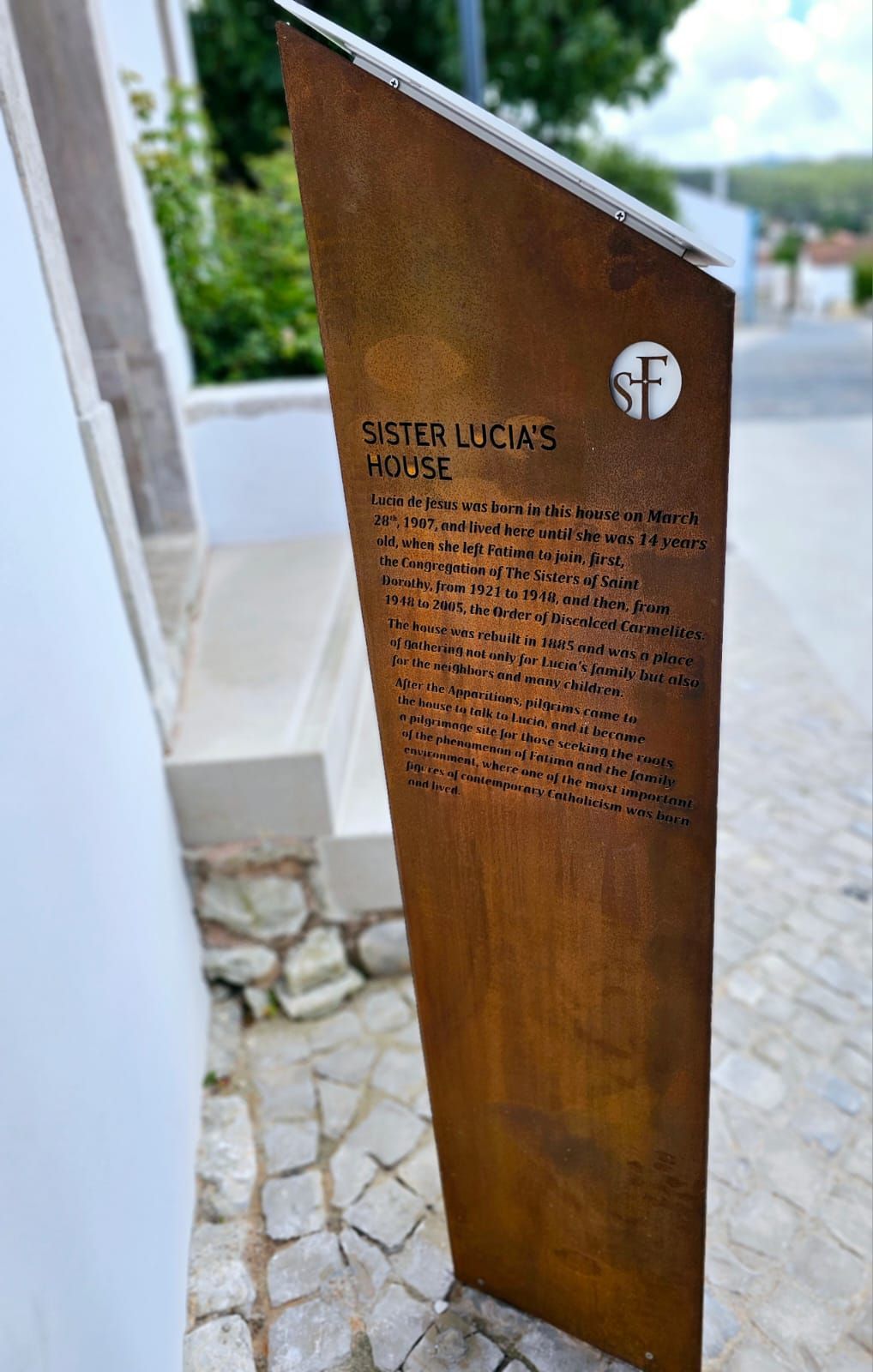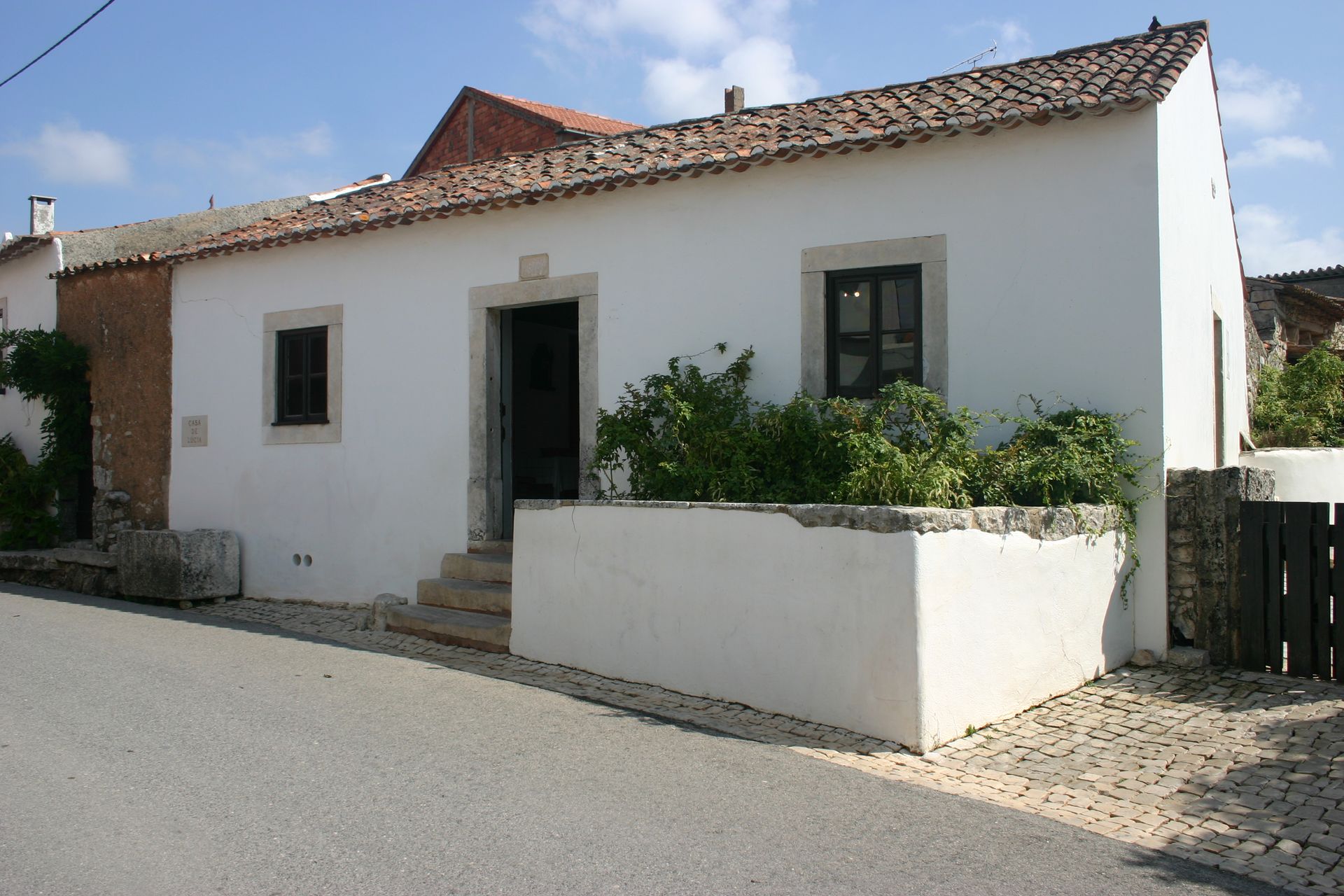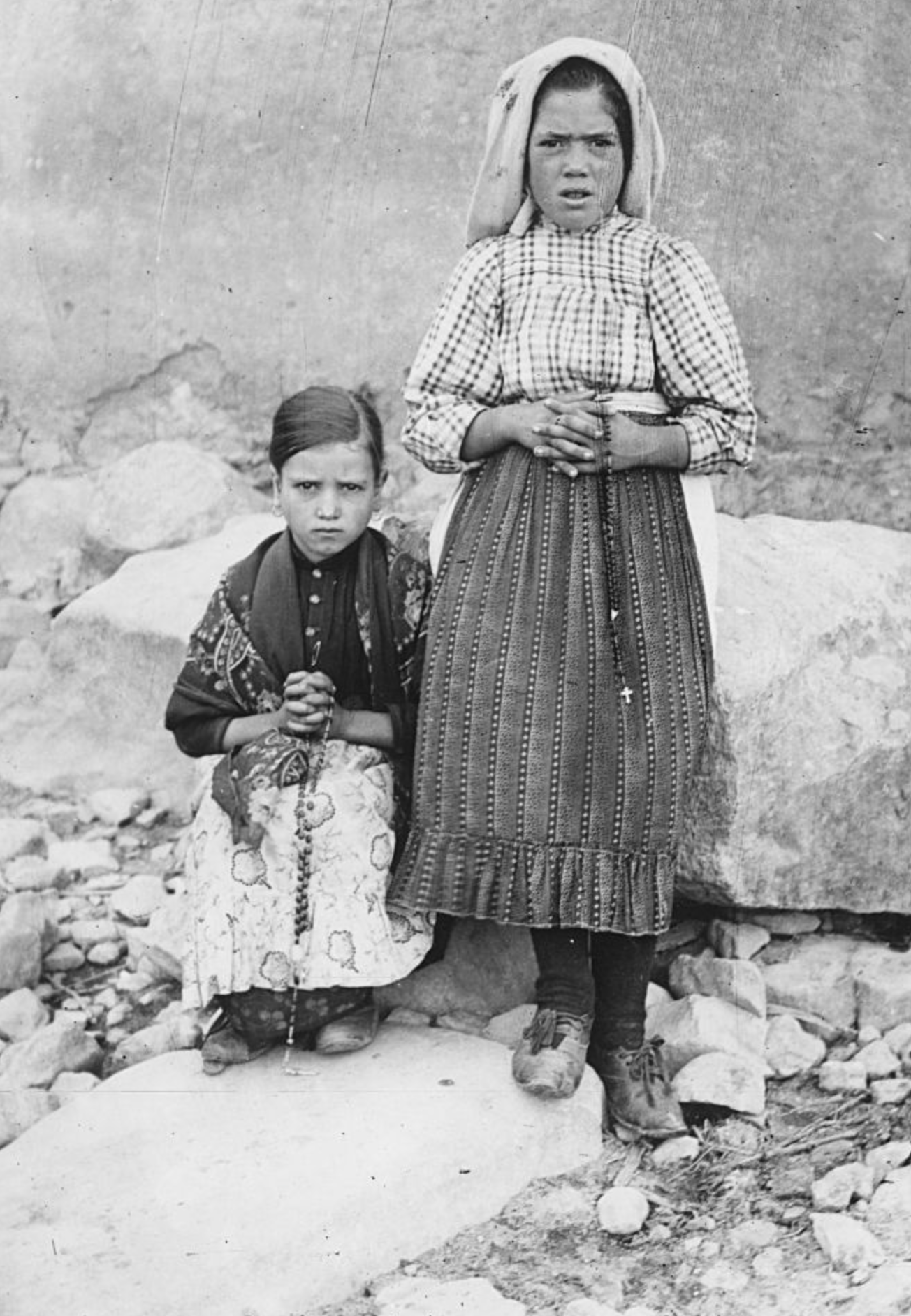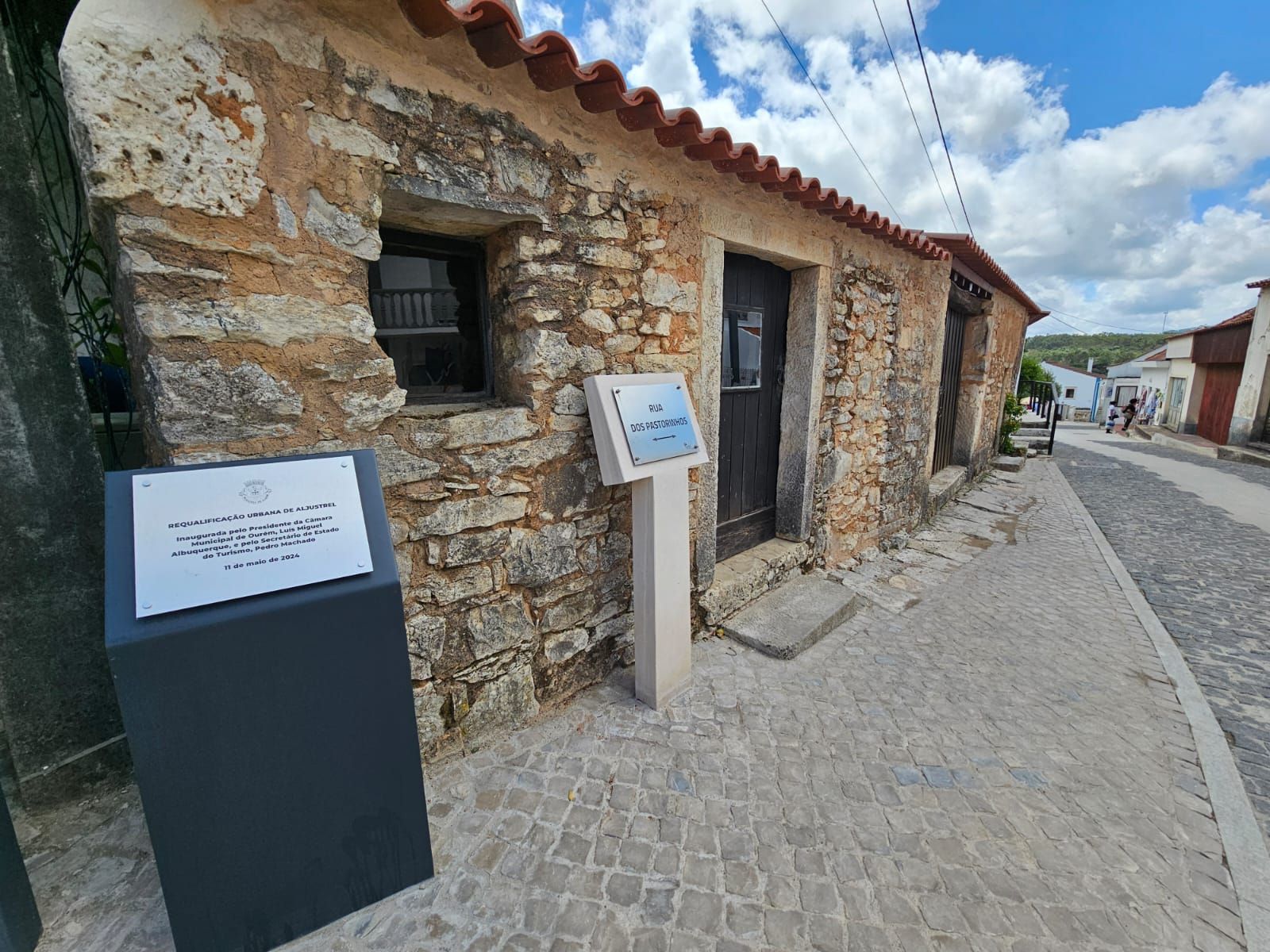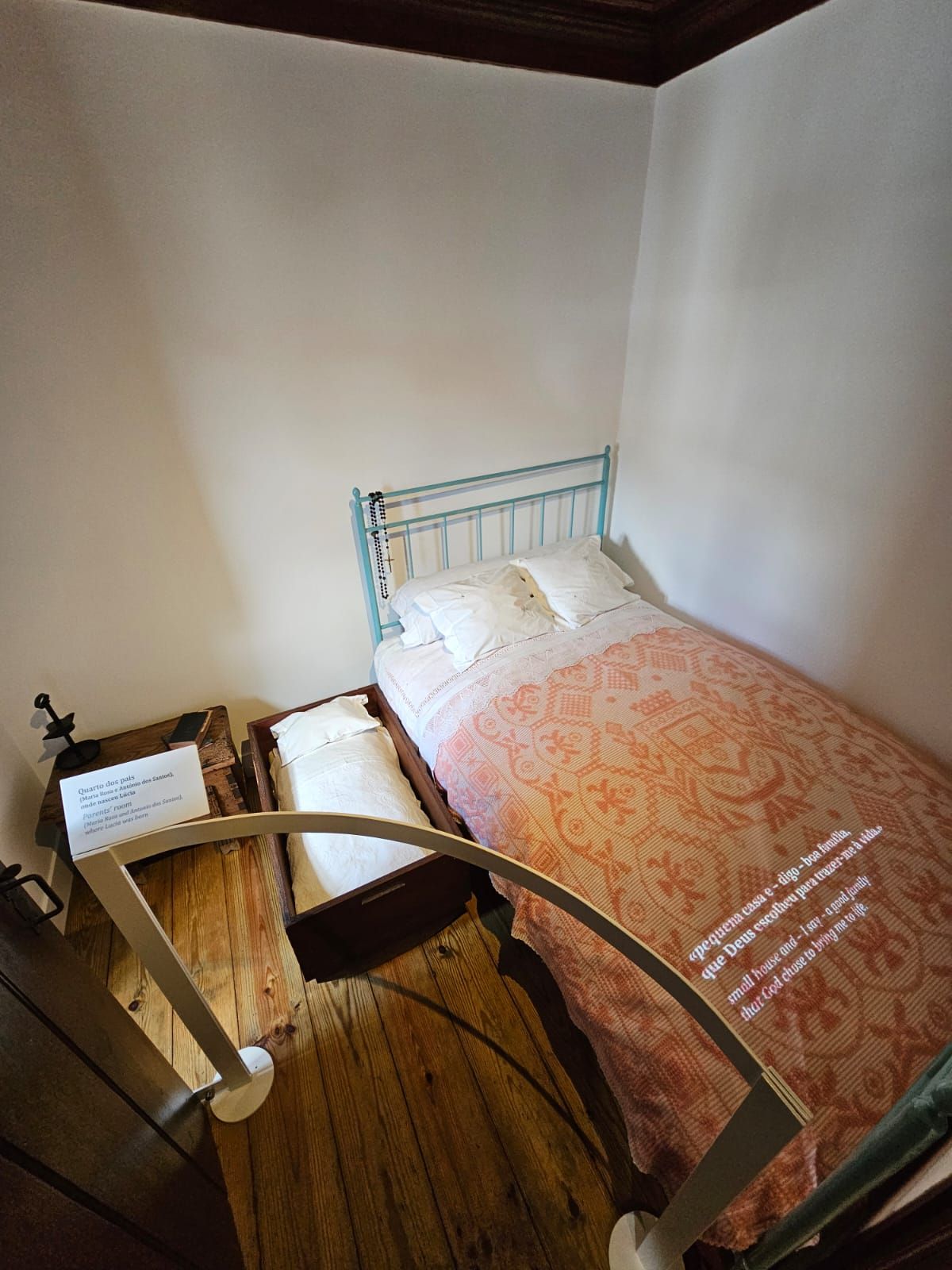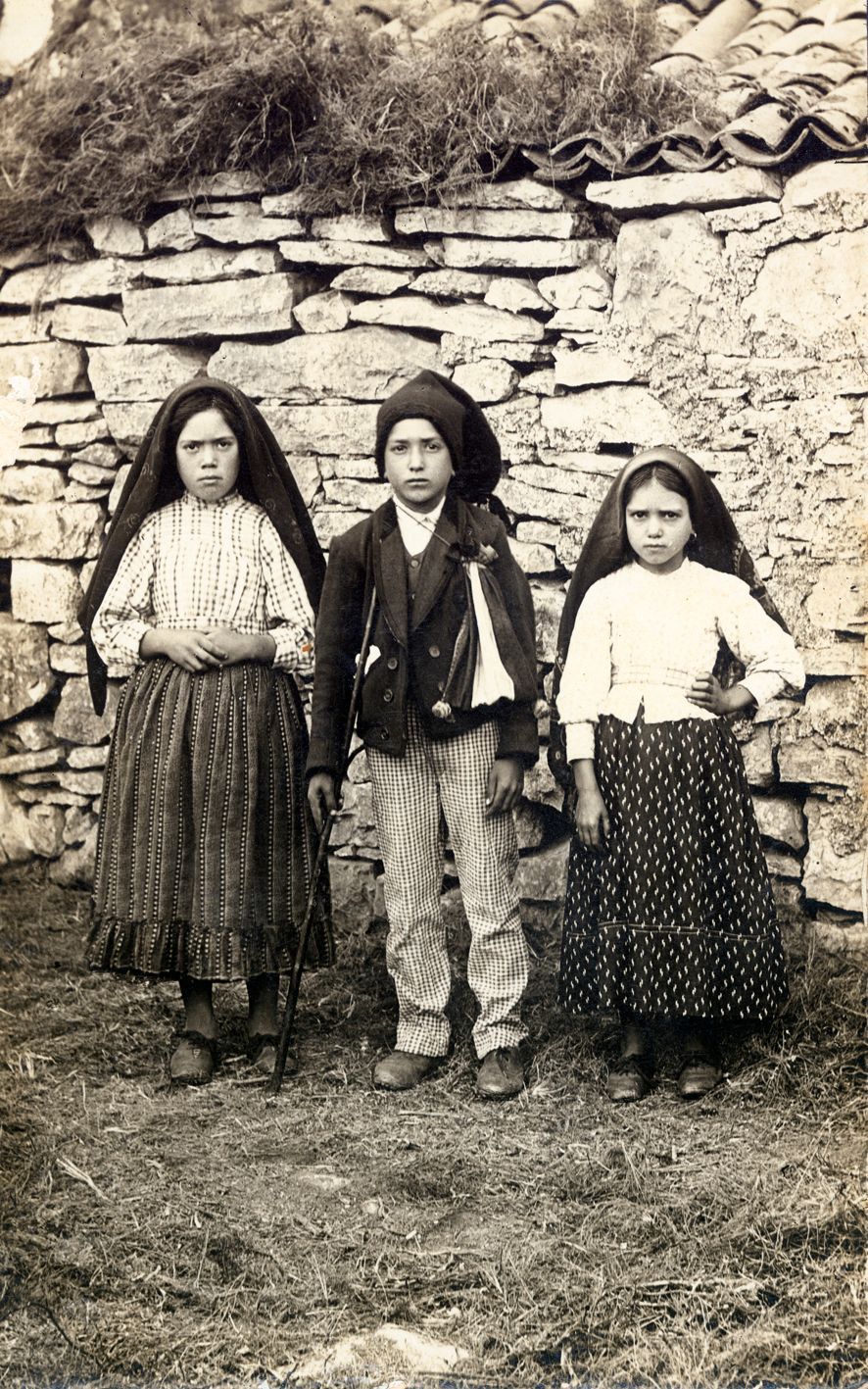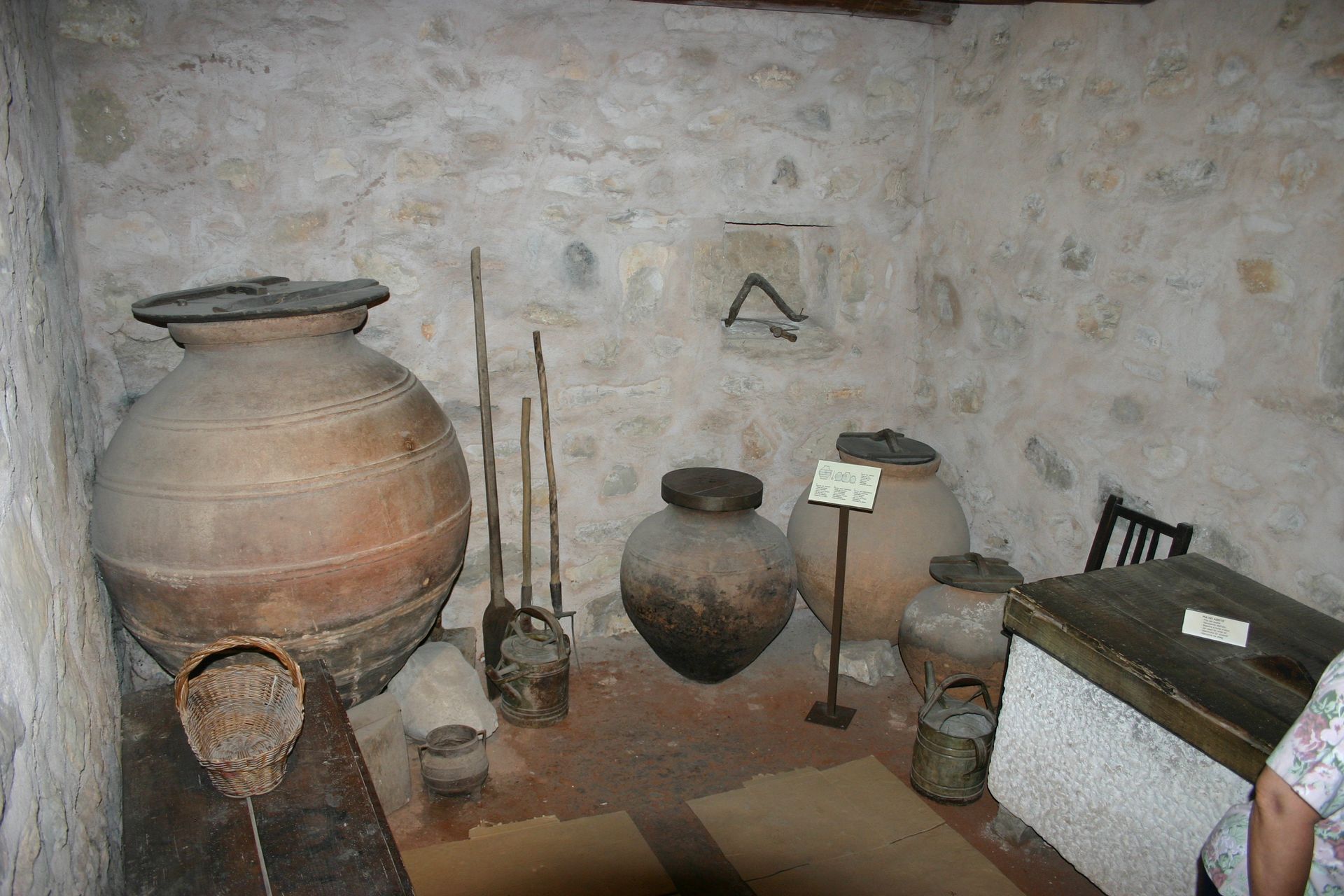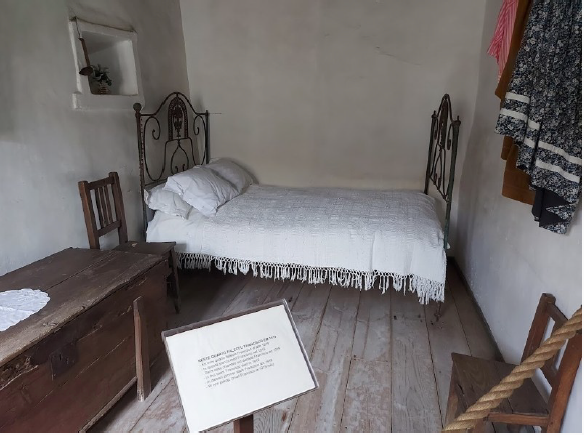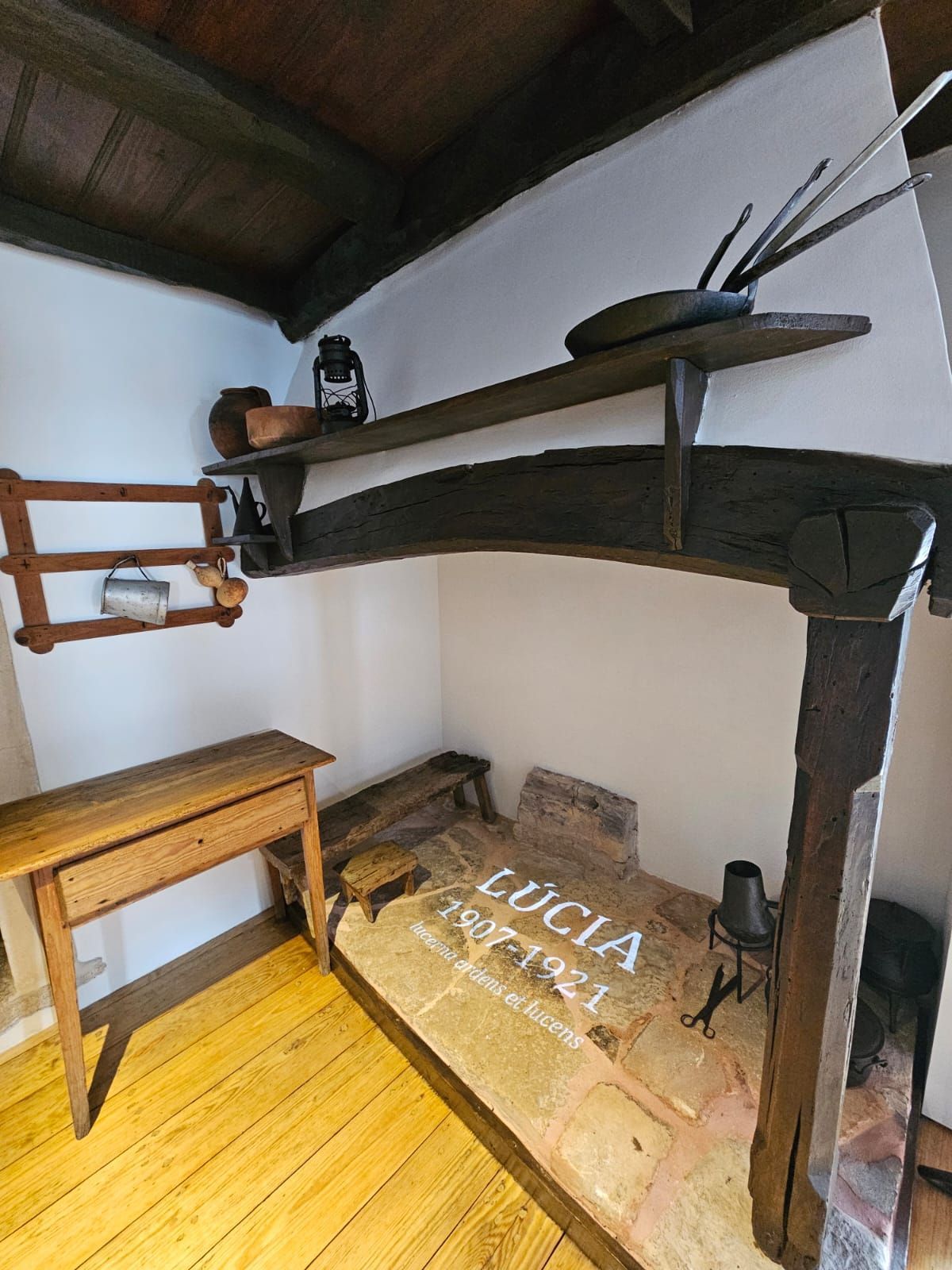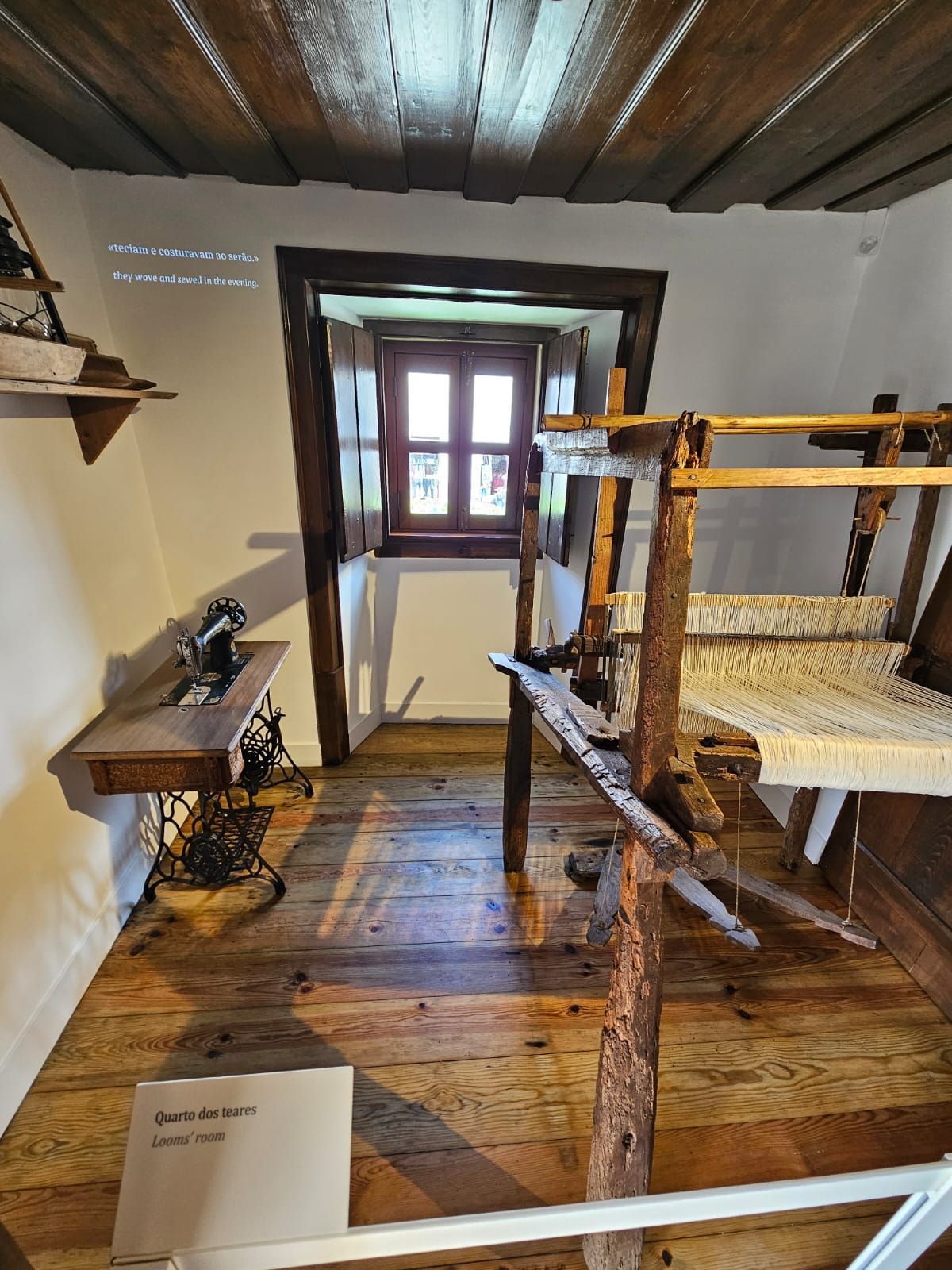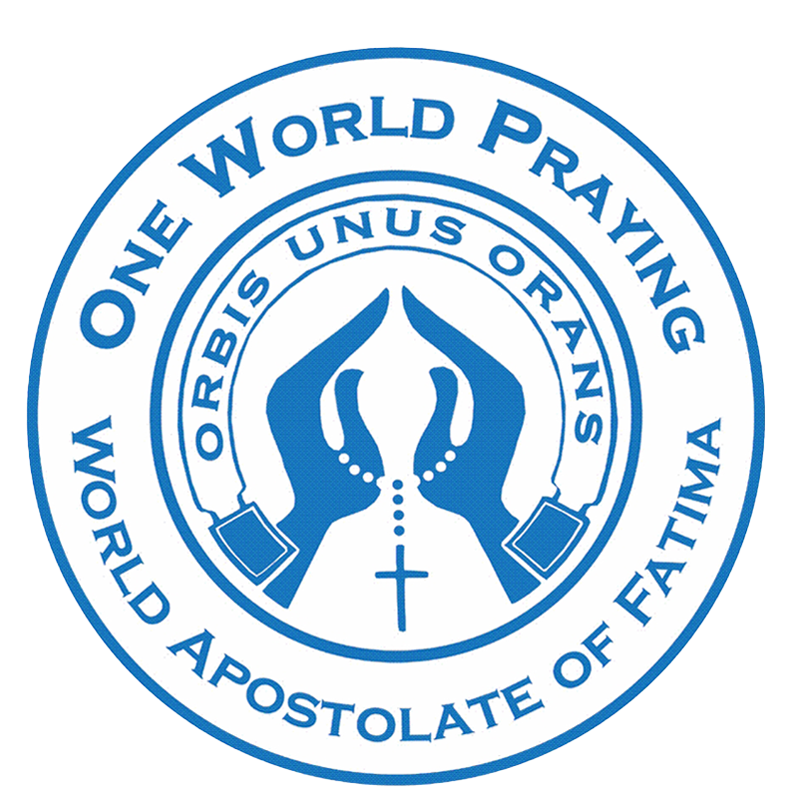The Seers of Fatima
The Fatima Seers were captivated by the beauty of God in the Most Holy Trinity and Jesus, Our Lady, St Joseph and the Angel. They were also enamoured at how wonderful it would be to be with them in heaven, that they were entirely willing to do whatever Our Lady asked. That is, to offer all their sufferings, penance, prayers and rosaries in reparation for the sins that offend God and the Immaculate Heart of Mary, and for the conversion of sinners, so that they too could go to heaven.
The Fatima Seers, the Little Shepherds, were Lucia dos Santos and her two cousins, brother and sister, Francisco and Jacinta Marto. The three children came from the hamlet of Aljustrel situated about 2 km from the Cova da Iria, where the apparitions of Our Lady took place.
Jacinta and Francisco were canonised in 2017 by Pope Francis, and in the light of their lives of heroic virtue, we can now say that the Church has, in essence, formally declared that living the message of Fatima according to their example is to set out on an assured path of personal sanctification in the school of Our Lady. All Catholics are called to this holiness.
In his Apostolic Exhortation, Christifideles Laici, (nn. 16, 17), Pope St John Paul II said that this holiness, is “the prime and fundamental vocation” of the lay faithful; and he also declared that “today we have the greatest need of saints whom we must assiduously beg God to raise up.”
The Spirituality of Jacinta, Francisco and Lucia
All three initially saw the Angel of Peace, or the Angel of Portugal, who appeared to them on three occasions during 1916, to teach them various prayers and prepare them for their meetings with the Mother of God, which took place on the thirteenth of each month from May to October 1917. During the Angel’s last apparition, they received the Eucharist, and following these encounters, they would spend hours on their knees in imitation of the Angel who had knelt down and bowed his forehead to the ground in adoration, as they repeated the first prayer he had taught them: “My God, I believe, I adore, I hope and I love You! I ask pardon of You for those who do not believe, do not adore, do not hope and do not love You!”
First apparition of Our Lady
By May 1917, Lucia was ten, Francisco nearly nine and Jacinta seven. The first apparition of Our Lady took place on the 13th. In Lucia’s words, they saw “a Lady, all dressed in white. She was more brilliant than the sun, and radiated a light more clear and intense than a crystal glass filled with sparkling water, when the rays of the burning sun shine through it” (Fatima in Lucia’s Own Words, vol I, 2007, p. 174).
Amongst other things, the Blessed Virgin told them that they would all go to heaven but that Francisco would need to say many rosaries first. When he was told what she had said, his joyous response was: “Oh, my dear Our Lady! I’ll say as many rosaries as you want!” And Lucia tells us that from that point onwards he often went apart to say the rosary by himself.
Thus Blessed Francisco can teach us the importance of prayer and particularly the daily recitation of the Rosary, which Our Lady specifically asked for during all six of her apparitions at Fatima. In her last words to the children on this occasion she said: “Pray the Rosary every day, in order to obtain peace for the world and the end of the war.” (Fatima in Lucia’s Own Words, vol I, p. 176).
Sin and Reparation
Mary also communicated an intense light from her hands to the children during this first apparition, a light which penetrated their hearts and souls, making them see themselves in God. Francisco later commented about this experience as follows: “I loved seeing the Angel, but I loved still more seeing Our Lady. What I loved most of all was to see Our Lord in that light from Our Lady which penetrated our hearts. I love God so much! But he is very sad because of so many sins! We must never commit any sins again.”
On one occasion, Jacinta remarked to Lucia: “Look, do you know this? Our Lord is sad, because Our Lady told us not to offend Him any more, for He is already very much offended; yet nobody takes any notice, and they continue to commit the same sins!”
Francisco became a true contemplative, and, as Lucia tells us, like Jacinta he advanced greatly in spiritual terms in a very short time, displaying a wisdom well beyond his years. His whole focus was to do everything he could to console Our Lord and he had to remind the two girls on occasion that childish games and pastimes were no longer appropriate, especially as Our Lady had told him and Jacinta that they were destined to go to heaven shortly, whereas Lucia was told that her mission was to remain on earth and spread devotion to Our Lady’s Immaculate Heart.
Eucharistic Prayer and Adoration
Once, when the children were on their way to school, Francisco said: “Listen, you go to school, and I’ll stay here in the church, close to the Hidden Jesus. It’s not worth my while learning to read, as I’ll be going to heaven very soon. On your way home, come here and call me.” Through the grace he had received from Our Lady, Francisco had conceived a deep love for Jesus, and in the short time left before his death in April 1919 he became a model of Eucharistic prayer and adoration.
Fatima and the Family
The importance of the Family
A very important aspect of Our Lady’s message, which only became apparent much later on, is that the lives of Francisco and Jacinta and their families, and also those of the other families in their village, reveal how the family itself is the bedrock of society, especially when it lives in accordance with the laws of God and the teaching of the Church; and equally, how important it is that the family as an institution should be supported. Lucia was the seventh and last child in her family, while Francisco and Jacinta were the last two of nine children born to their mother, who had two children by an earlier marriage and was then widowed.
In her old age, Sr Lucia wrote two further memoirs, on life at home with her father and mother, which were first published in 1999 as vol II of Fatima in Lucia’s Own Words, when Lucia was already 92 years old. Thanks to her prodigious memory, in this volume she relates stories which give a wonderful picture of the early lives of the seers at home and how they were deeply permeated by their Catholic faith. By comparison with today’s materialistic society they were poor, but they were very happy. Today when the family is threatened by many harmful influences, the lives of the shepherd children demonstrate the crucial importance of Christian values in upholding the traditional role of the family for the wellbeing of society.
The Depth of Jacinta's Spirituality
Jacinta’s love for the Holy Father
Two priests, who had come to question the children, recommended that they pray for the Holy Father, prompting Jacinta to ask who the Holy Father was. The good priests explained who he was and how much he needed prayers, and this gave Jacinta such love for the Holy Father that every time she offered her sacrifices to Jesus, she added: “and for the Holy Father.” At the end of the Rosary, she always said threeHail Marys for the Holy Father, and sometimes she would remark: “How I’d love to see the Holy Father! So many people come here, but the Holy Father never does!”
In her childish simplicity, she supposed that the Holy Father could make this journey just like anybody else!
Jacinta also had two visions of the Holy Father. In the first, she saw the Holy Father in a very big house, kneeling, with his head in his hands and weeping. In the crowd outside, some were throwing stones and others were cursing him. In the second vision, she saw roads and fields full of people crying with hunger and the Holy Father in a church praying before the Immaculate Heart of Mary. (Fatima in Lucia’s Own Words, vol I, pp. 128, 129).
So Jacinta can teach us to have a great devotion for the Holy Father, the Pope, especially nowadays when he is increasingly being attacked. The first Pope to go to Fatima was Paul VI in 1967; John Paul II went on three occasions, in 1982, 1991 and 2000, and more recently Pope Benedict XVI went on pilgrimage to the shrine in 2010, for the tenth anniversary of the beatification by his predecessor of Francisco and Jacinta.
Jacinta and the vision of hell
How was it, asked Lucia, that a child so young as little Jacinta understood the spirit of mortification and penance so well and embraced it so willingly. The reason is that God gave her a special grace of devotion to the Immaculate Heart of Mary, and secondly, because she had seen the ruin of souls in hell, and that the way to save souls from going there was devotion to her Immaculate Heart, as Our Lady said when the vision ended.
In her great desire to save souls from being lost, Jacinta even asked, “Why doesn’t Our Lady show hell to sinners ? If they saw it, they would not sin … You’ll see how they will be converted”. (Fatima in Lucia’s Own Words, vol I, p. 125).
Jacinta and the Immaculate Heart of Mary
Jacinta used to say little ejaculatory prayers to Our Lady again and again. Her favourite was, “Sweet Heart of Mary, be my salvation … I so love the Immaculate Heart of Mary, it is the heart of our dear Mother in heaven”.
A little while before going to hospital, Jacinta said to Lucia: “It will not be long now before I go to heaven. You will remain here to make known that God wishes to establish in the world devotion to the Immaculate Heart of Mary. When you are to say this, don’t go and hide. Tell everybody that God grants us graces through the Immaculate Heart of Mary; that people are to ask her for them; and that the Heart of Jesus wants the Immaculate Heart of Mary to be venerated at His side. Tell them also to pray to the Immaculate Heart of Mary for peace, since God has entrusted it to her. If I could only put into the hearts of all, the fire that is burning within my own heart, and that makes me love the Hearts of Jesus and Mary so very much!” (Fatima in Lucia’s Own Words, vol I, pp. 128, 132).
One day, Lucia was given a holy picture of the Heart of Jesus, quite a nice one, as man-made pictures go. She asked Jacinta: “Do you want this holy picture?” She took it, looked at it attentively, and remarked: “It’s so ugly! It doesn’t look like Our Lord at all. He is so beautiful! But I want it; it is He just the same.”
She always carried it with her. At night and during her illness, she kept it under her pillow, until it fell apart. She kissed it frequently, saying: “I kiss the Heart, because I love it most! How I would love to have a Heart of Mary! Don’t you have one? I’d love to have the two together.” (Fatima in Lucia’s Own Words, vol I, p. 133).
Jacinta and the Eucharist
On another occasion, Lucia brought her a picture of a chalice with a host. She took it, kissed it, and radiant with joy she exclaimed: “It is the Hidden Jesus! I love Him so much! If only I could receive Him in church! Don’t they receive Holy Communion in heaven? If they do, then I will go to Holy Communion every day. If only the Angel would go to the hospital to bring me Holy Communion again, how happy I would be!”
Sometimes, on returning from church, Lucia went in to see her, and she asked her:
“Did you receive Holy Communion?” And if Lucia answered “yes,” she said: “Come over here close to me, for you have the Hidden Jesus in your heart.”
At other times, she told Lucia: “I don’t know how it is! But I feel Our Lord within me. I understand what He says to me, although I neither see Him nor hear Him, but it is so good to be with Him!”
These three characteristics of her spirituality—love for the Pope, for Our Lady and for the Eucharist—are also found in many of the new communities, and are hallmarks of an authentic Catholic spirit.
The Fatima Seers after the apparitions
Jacinta and Francisco
An influenza epidemic swept Europe in the autumn of 1918, just as the War was ending, and both Jacinta and Francisco fell ill. Francisco recovered somewhat and there were hopes that he might become well, but he realized that he was destined to die young, as Our Lady had foretold, and his condition worsened again. He offered up all his sufferings as a way of consoling God for the sinfulness and ingratitude of mankind, becoming so weak that eventually he could not even pray. On the day before he died, he received his first Holy Communion, and said to Jacinta, “I am happier than you are because I have the hidden Jesus in my heart”. Lucia wrote that he took his flight to heaven on the next day, 4 April 1919, “in the arms of his heavenly Mother”. His father said that he died smiling.
Jacinta, too, was confined to her bed during the long winter months, and although she recovered, was struck down with bronchial pneumonia, while also developing a painful abscess in her chest. She was moved to the hospital in Ourem in July 1919, where she underwent the painful treatment prescribed for her, but without much effect, returning home in August with an open wound in her side.
Our Lady appeared to her and asked Jacinta is she wanted to convert more sinners; she said that she did. Our Lady then said she would have suffer much for the conversion of sinners and in reparation for the sins committed against her Immaculate Heart, and that she would die in hospital all alone. Realising this, Jacinta said, “O my Jesus, now you can convert many sinners, because this is a really big sacrifice”.
Eventually, in February 1920, she was admitted to hospital in Lisbon, where she underwent another painful operation to remove two ribs, without being given a general anaesthetic; this left her with a large wound in her side that had to be dressed daily, causing her agony. She endured the suffering with heroic patience, and made her confession and died on the evening of 20 February 1920. However, the priest declined to give her Viaticum as he could not see any signs of imminent death, and so she died later that night without being able to receive it.
Lucia after the Apparitions
Lucia eventually became a Dorothean Religious Sister, and on 10 December 1925, while at the convent inPontevedra, Spain, she saw another apparition, this time of Mary with the Child Jesus. Mary told Lucia that she promised all the graces necessary for salvation to those who, on the first Saturday of five consecutive months, confessed, received Holy Communion, recited five decades of the rosary, and meditated on the rosary for fifteen minutes, all with the intention of making reparation to her Immaculate Heart.
On 13 June 1929 Sr. Lucia, while at prayer in the convent chapel at Tuy, saw a vision of the Most Holy Trinity, with Mary standing on the altar displaying her Immaculate Heart in her left hand. It was on this occasion that Mary asked the Pope, in union with all the bishops of the world, to make the [collegial] consecration of Russia to her Immaculate Heart that she had announced during the July 1917 apparition.
On 12 September 1935 Jacinta’s body was translated from Ourem to Fatima cemetery, and placed beside the remains of her brother Francisco. On 1 May 1951, her remains were again translated, this time to a new tomb in the Basilica at the Cova da Iria. On 13 March 1952, Francisco’s remains were also translated to the Basilica.
In March 1948, Sr Lucia entered the Carmelite convent of St. Teresa in Coimbra, having received special papal permission to leave the Dorothean Sisters and become a Carmelite. She died at the age of 97 on 13 February 2005, having been a Carmelite Nun for more than 50 years. Her remains were interred in the Basilica at Fatima, in a tomb alongside that of Jacinta. Pope Benedict XVI announced, on 13 February 2008, the third anniversary of her death, that in Sr. Lucia’s case of he would waive the usual five year period before opening the cause for her beatification, which puts her cause in the same category as that of Pope John Paul II and Mother Teresa.
The Beatification of Jacinta and Francisco
Pope John Paul II beatified Jacinta and Francisco in Fatima in May 2000, thus giving them to us as the perfect examples of how to live the Fatima message and thereby become sanctified in the normal course of our daily lives, as they did, simply by doing everything Our Lady asked of them. Their beatification means that the Church has formally recognised that to live the message of Our Lady of Fatima is to follow a path of personal sanctification, and thus the Fatima message is exceptionally relevant for the Church and in particular for the family in the difficult times in which we are living. When in due course they are canonized, Francisco and Jacinta will become the first non-martyr child saints in the history of the Church who died after living lives of heroic virtue in their family.
Bl Francisco and Jacinta strove to fulfil the requests of Our Lady with the utmost fidelity and commitment, and it was this, said Bl John Paul II at their beatification, that enabled them to attain heroic virtue, and not because of the extraordinary supernatural manifestations which they were privileged to experience. Hence it is particularly important for families to follow their example in our times, when marriage is under unprecedented attack in our secularised society, and when so many children abandon the practice of their faith on leaving school.
Living the message of Fatima in the family, so that they may become “places of communion and prayer, authentic schools of the Gospel and small domestic churches” (Pope Francis, Feast of the Holy Family, December 2013), and especially the daily praying of the Rosary, as the Popes have continually urged, and Our Lady herself urged at Fatima, would halt and reverse the collapse of faith that has been doing such harm to the Church.
Blessed Francisco and Jacinta—who were described by Bl John Paul II at their beatification as “two candles which God lit to illumine humanity in its dark and anxious hours”—will be canonized when a second miraculous cure is obtained through their intercession. Then they will become the youngest non-Martyr saints in Church history, and as such their wonderful example of loving and faithful devotion to God and Our Lady will no doubt exert a far wider influence in the future, and help to bring about the new Civilization of Love which the Church and the world so greatly needs.
THE CHILDREN OF FATIMA
The above is a brief insight into the rich treasure of stories about the lives of Saints Jacinta and Francisco, that Sr Lucia recollected so faithfully, and in such extraordinary detail, in the first volume of her Memoirs, Fatima in Lucia’s Own Words. This is the best book for anyone who desires a more in depth treatment of this subject. Another good source is the short CTS Booklet, What Happened At Fatima by Leo Madigan, or alternatively, Fatima For Today by Fr Andrew Apostoli, is the most comprehensive and up-to-date account of the apparitions currently available.
Meanwhile, work on the construction of the Capelinha, the Chapel of Apparitions, began on 28 April 1919 and was completed on 15 June; the first Mass was celebrated there on 13 October 1921. The pedestal on which the image of Our Lady stands in the Capelinha marks the exact spot where the little holm oak grew on which Our Lady appeared. In May 1922, Bishop Jose Correia da Silva of Leiria-Fatima, named a commission of enquiry to analyse the facts surrounding the Fatima phenomenon “with strictness and impartiality”.
On 10 December 1925, Sr Lucia, who had become a postulant with the Dorothean Sisters, was at their convent in Pontevedra, Spain, when she saw another apparition, this time of Mary with the Child Jesus. Mary told Lucia that she promised all the graces necessary for salvation to those who, on the first Saturday of five consecutive months, confessed, received Holy Communion, recited five decades of the rosary, and meditated on the rosary for fifteen minutes, all with the intention of making reparation to her Immaculate Heart.
Meanwhile, on 13 January 1924, Mass was celebrated for the first time inside the Capelinha, while on 26 June 1927, the bishop presided for the first time at an official event—the inauguration of the 14 kilometre Way of the Cross to the Cova da Iria, where he celebrated Mass in the presence of 400 pilgrims. Building work on he Basilica of Our Lady of the Rosary of Fatima was begun in 1928, and it was consecrated on 7 October 1953. It has 15 altars dedicated to the 15 mysteries of the Rosary. The bodies of Jacinta and Francisco were moved to their present positions, to the left and right of the main altar, in the early 1950s, and Sr Lucia’s body was interred in the Basilica in 2008 next to Jacinta’s. The mortal remains of Bishop Correia da Silva, who died in 1957, are interred in the Chancel.
Prior to this, on 13 June 1929 Sr. Lucia, while at prayer in the convent chapel at Tuy, saw a vision of the Most Holy Trinity, with Mary standing on the altar displaying her Immaculate Heart in her left hand. It was on this occasion that Mary asked the Pope, in union with all the bishops of the world, to make the [collegial] consecration of Russia to her Immaculate Heart that she had announced during the July 1917 apparition.
On 13 October 1930 the Bishop issued a pastoral letter on the apparitions, which, after recounting the events at Fatima, contained the following brief but important statement:
“In virtue of considerations made known, and others which for reasons of brevity we omit; humbly invoking the Divine Spirit and placing ourselves under the protection of the most Holy Virgin, and after hearing the opinions of our Rev. Advisors in this diocese, we hereby:
- Declare worthy of belief, the visions of the shepherd children in the Cova da Iria, parish ofFatima, in this diocese, from the 13th May to13th October, 1917.
- Permit officially the cult of Our Lady of Fatima.”
In thanksgiving for this development, six months later, on 13 May 1931, a vast pilgrimage of around 300,000 people came to Fatima to participate in a ceremony presided over by Cardinal Cerejeira, Patriarch of Lisbon, at which all the bishops of Portugal made the first consecration of their country. It was this consecration, and that of 1938, which preserved Portugal from the violent attack on the Church in the Spanish Civil War, and its renewal in 1940 saved Portugal from being dragged into the horrors of the Second World War.
Fatima developments from World War II onwards
On 31 October 1942, during World War II, Pope Pius XII, speaking in Portuguese by radio, consecrated the world to the Immaculate Heart of Mary, with a special mention of Russia, in response to the request he had received in a letter from Sr Lucia. Some months later Sr Lucia said that as a result of this act, God promised to end the war soon.
On 13 May 1946, Cardinal Masella, the Papal Legate, crowned the Statue of Our Lady of Fatima in the Capelinha as Queen of Peace. This crown was made from gold melted down from wedding rings donated by the women of Portugal, and it also contains over 4,000 precious stones, which they contributed in thanksgiving for Portugal having been spared the horrors of the Spanish Civil War and the Second World War.
On 13 October 1951, Cardinal Tedeschini, who was in Fatima for the closing of the Holy Year, revealed that in October 1950, at the time when he had promulgated the dogma of Mary’s Assumption into heaven, Pope Pius XII had witnessed a repetition of the solar miracle of 13 October 1917, while he was walking in the Vatican gardens.
Cardinal Roncalli, the Patriarch of Venice, and the future Pope John XXIII, presided at the ceremonies at Fatima on 13 May 1956, while, on 21 November 1964, Pope Paul VI, at the conclusion of the third session of the Second Vatican Council, proclaimed “the Most Blessed Mary Mother of the Church”; the Pope also considered it was “particularly opportune” to recall Pius XII’s consecration of the world to the Immaculate Heart of Mary; and bearing that consecration in mind, he announced before the 2,500 Council Fathers, that a Golden Rose was to be presented to the Sanctuary of Fatima (this act was carried out on 13 May 1965 by Cardinal Cento, the Papal Legate); and the Pope concluded his address by proclaiming, “to your Immaculate Heart, O Mary, we commend the entire human race”.
Pope Paul VI came to Fatima on 13 May 1967 to celebrate the 50th anniversary of Our Lady’s first Apparition, and to pray for world peace and Church unity. In a significant sign of papal approval for the message of Fatima, the Pope invited Sr Lucia to join him on the external altar in front of the crowds, and in his Apostolic Exhortation Signum Magnum, issued on the same day, Paul VI urged “all members of the Church to consecrate themselves once again to the Immaculate Heart of Mary and to translate this pious act into their daily lives”.
Ten years later, on 10 August 1977, the future Pope John Paul I, Cardinal Luciani, Patriarch of Venice, came on pilgrimage to Fatima.

